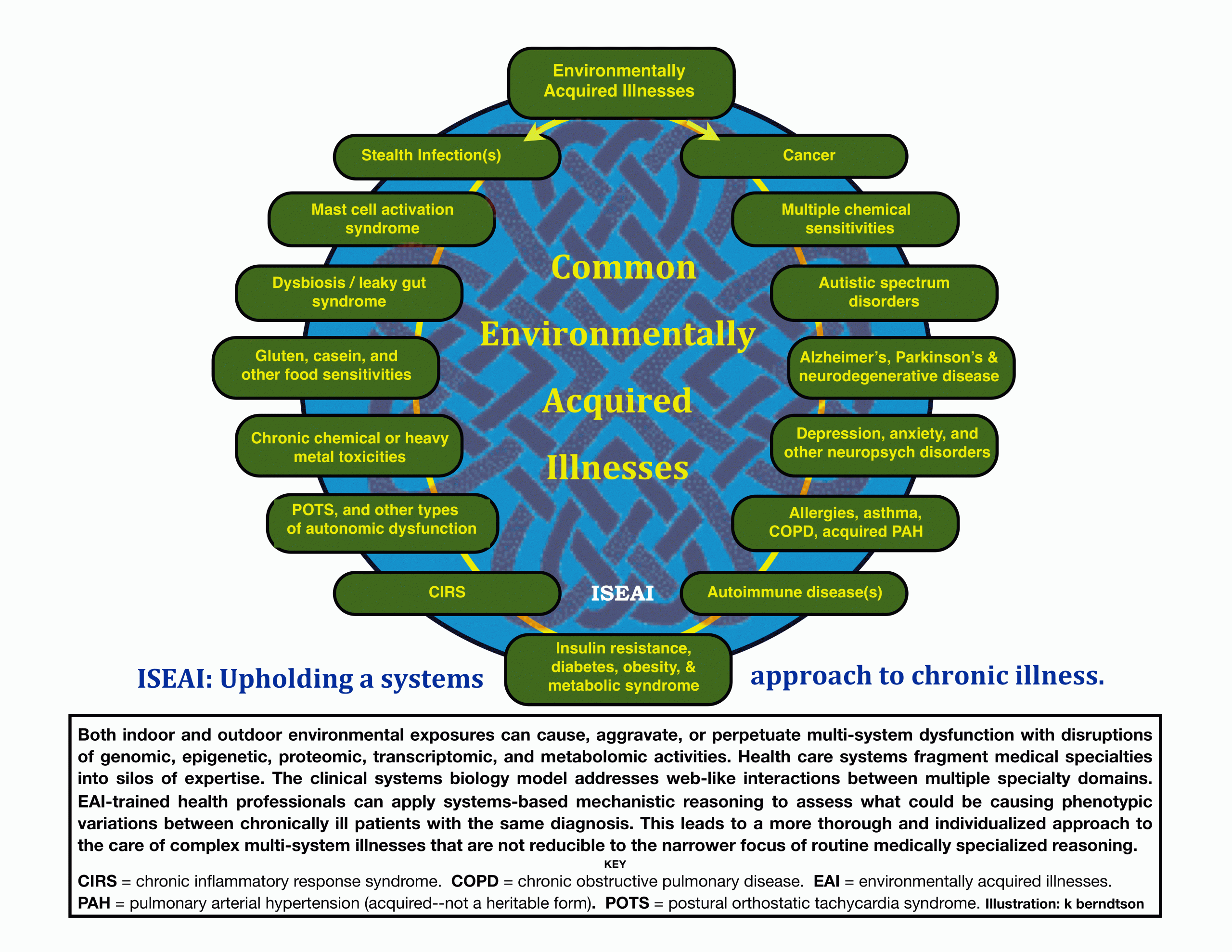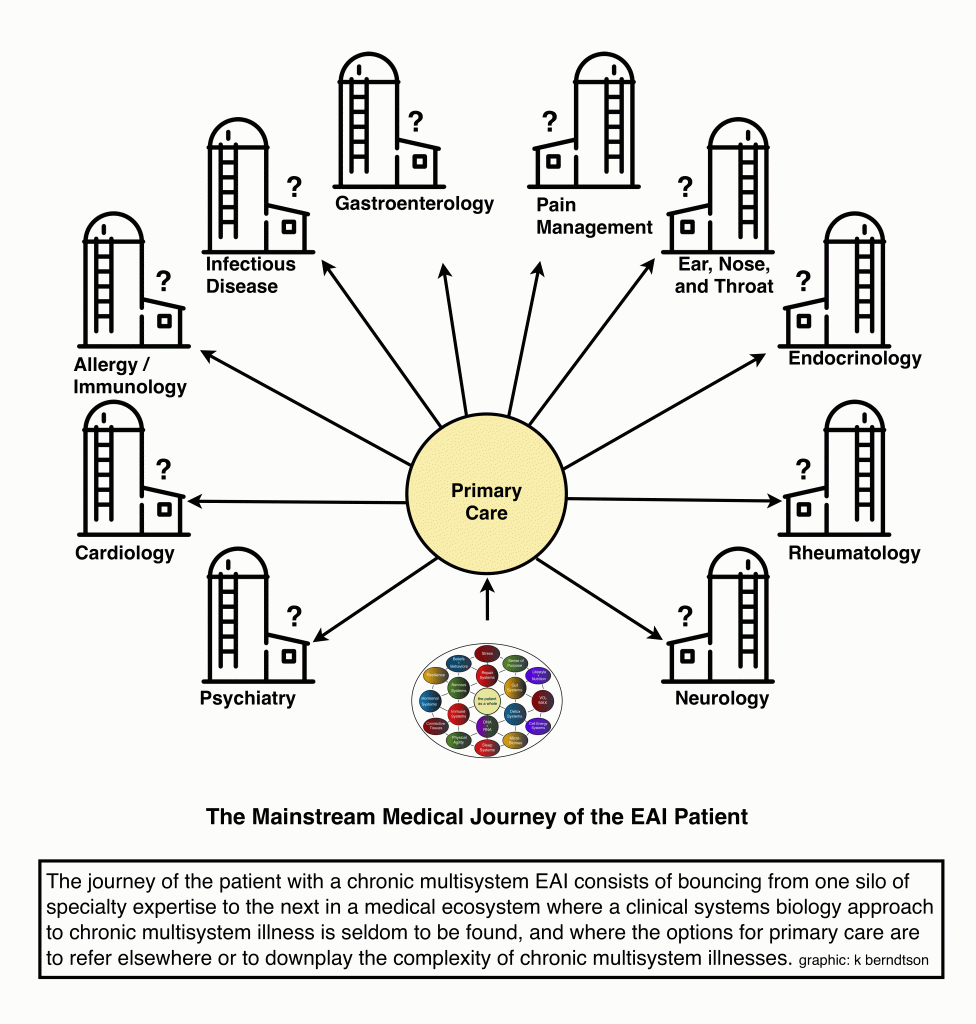A New Lens on Health and the Environment
Medical research is exploding with findings that associate man-made and microbe-made toxins with chronic forms of human illness. [1] A broad mix of indoor airborne molecular threats, when repeatedly inhaled, can trigger chronic inflammation driven by overactivation and dysregulation of the innate immune response.
Repeatedly ingested food-borne toxins can cause tissue damage to the gut and lungs [2]. Chronic exposures to persistent organic pollutants cause diseases of metabolism [3,4]. Maternal immune activation during pregnancy caused by infection or diverse other environmental exposures may elevate the risk of delivering a child destined to join the autistic spectrum. [5]. Causes of Alzheimer’s disease include chronic neuroinflammatory and toxicity effects produced by immune evasive brain infections and/or exposure to indoor air in chronically damp buildings. [6].
Bridging the Gap Between Conventional Medicine and EAI
In health care today there exists a glaring knowledge gap when it comes to the prevention, diagnosis, and treatment of environmentally acquired illnesses (EAI). ISEAI is committed to bridging this gap by pursuing collaborative efforts to: a) raise public awareness, and b) educate health care professionals about EAI so they can gain the expertise needed to evaluate and treat the various aspects of it.
The patient who has seen many doctors only to be told that nothing was wrong is likely a patient whose suffering likely involves one or more forms of EAI. The patient diagnosed with fibromyalgia whose every treatment failed or made him feel worse, is likely a patient who suffers from one or more forms of EAI. These missed diagnoses have one lesson in common: doctors always miss what they’re not looking for.
Patients with EAI are disenfranchised by the EAI blind spot that exists in most conventional medical settings. They often feel dehumanized by the cookbook approach to diagnosis and treatment of their multidimensional problems. ISEAI is intent on rectifying this sorry state of affairs in our health care system. Examples of common illnesses known to be caused, aggravated, or perpetuated by environmental exposures are shown in the table below.
- Allergies and asthma
- Alzheimer’s disease
- Autistic spectrum disorders
- Autoimmune disease(s)
- Autonomic nervous system dysfunction(s)
- Cancers of solid tissue and blood
- Chemical toxicities
- Chronic obstructive pulmonary disease (COPD)
- Diabetes (Type 2)
- Dysbiosis / leaky gut syndrome (LGS)
- Electromagnetic/EMF Hypersensitivity (EHS)
- Ehlers-Danlos syndromes (EDS)
- Gluten, casein, and other food sensitivities
- Heavy metal toxicities including Mercury, Lead, Arsenic and Cadmium
- Small Intestinal Bacteria Overgrowth (SIBO)
- Stealth infections including Bacterial (Borrelia, Bartonella, Mycoplasma), Viral (EBV, HHV-6, Coxsackie) and Parasital (Babesia, intestinal helminths and parasites)
- Insulin resistance
- Mast cell activation syndrome (MCAS)
- Metabolic syndrome
- Mold Illness/Chronic Inflammatory Response Syndrome (CIRS)
- Multiple chemical sensitivities (MCS)
- Neuropsychiatric and neurocognitive syndromes
- Obesity
- Parkinson’s disease
- Postural orthostatic tachycardia syndrome (POTS)
EAI Evaluation and Management Requires a Systems Medicine Approach
Environmentally acquired, aggravated, and perpetuated medical conditions exist in varied combinations. This drastically increases the complexity of the clinician’s cognitive task. For this reason, the focus of EAI-trained clinicians is to identify which root-level causes are active in each unique patient. This is the hallmark of what we call the clinical systems biology (CSB) approach to complex forms of chronic illness.
Disrupted interactions between bodily systems can lead to multiple symptoms that defy explanation to those who rely upon business-driven narrowly drawn clinical mindsets. This is why EAIs tend to bewilder medical specialists–they are not trained to think like clinical systems biologists. Their clinical mindsets are framed by “expert” guidelines set for those who practice within each specialty realm. Not to mention that conflicts of interest abound in these arrangements yet to diverge from such guidelines carries professional risk, making it less likely that a medical specialist will ever feel comfortable exploring the advantages of a CSB mindset.
Based on attendance numbers for events hosted by the Institute of Functional Medicine and the American Integrative and Holistic Medicine Association, we find a growing number of medical specialists seeking active engagement in programs designed to teach functional and integrative medicine. Including EAI expertise in the care of treatment resistant multisystem illnesses seen in all medical specialties will improve overall quality of care across medical specialties and primary care. ISEAI is here to collaborate with like-minded organizations to help make this paradigm shift happen.
The Clinical Systems Biology Mindset
Patients with a chronic multisystem illness can benefit from health professionals with systems biology expertise. The graphic below indicates a few of the many bodily system variables that can play causal roles in EAIs.
It is not uncommon for patients with EAI to bounce between ten or more specialists before reaching someone with expertise in EAIs. This includes common EAIs like chronic inflammatory response syndrome (CIRS), mast cell activation syndrome (MCAS), persistent stealth infections, and leaky gut syndrome (LGS). Using a CSB mindset, the EAI expert sets out to identify which root level causes best explain otherwise unexplained forms of complex, chronic forms of multisystem illness.
The CSB mindset applies mechanistic and physiological reasoning to identify what makes one patient different from another with the same diagnosis. CSB reasoning relies on a deep understanding of how the various systems of the human body work together to maintain healthy balance. Commonly seen patterns of abnormality indicate how and why key bodily systems falter and fail, resulting in multisystem illnesses that befuddle those who are trapped into naming the disease and the drug for the disease in order to keep moving and meet the day’s productivity expectations. These expectations are somehow backed by “evidence-based” clinical guidelines that are guaranteed to fail those whose conditions are environmentally acquired and so hard to explain by the EAI-blind.
Environmental exposures pose growing threats to the physiological equilibrium of our bodily systems.The global medical profession must do a better job of recognizing what’s going on in our indoor and outdoor environments. These patterns warrant investigation because the better we understand the root causes of EAI, the better we’ll get at preventing, diagnosing, and treating the many EAI effects on health and wellness.
Our health care system positions primary care physicians (PCPs) as gatekeepers. Too pressed for time to look for solutions to chronic multisystem illnesses, PCPs tend to refer such patients to one specialist after another. It sounds cynical but it is often true that the most efficient way for a PCP to stay on time, is to narrow the discussion to the one thing that his hurried visit will be about.
Do not blame the PCPs who are forced to practice this way. Blame ridiculous insurance reimbursement and documentation requirements, and the insanely unrealistic productivity targets that PCPs are expected to meet these days. Nine or ten minutes per visit effectively rules out any chance for a thoughtful evaluation of a complex, chronic, and hard to explain multisystem illness.
The specialist is allowed more time to devote to clinical evaluation and care planning. Specialist expertise is in-depth but the scope of expertise is kept within narrowed bounds to avoid crossing into the territory of other specialists. The CSB mindset crosses those borders and draws knowledge from how multiple medical specialties would address what’s going on with a given patient. The CSB mindset draws upon methods that are more scientific, patient-centered, holistic, integrative, naturopathic, and functional when it comes to solving the chronic and complex problems of human biology gone awry.
We want more specialists to develop the CSB mindset and to learn the skills of functional and integrative medicine that are so relevant to caring for persons with chronic multisystem illnesses. Successful diagnosis of EAIs requires a clinical mindset that is open to sources of evidence beyond those that rely on scientific reductionism and the quest for the Holy Grail of specific causation.
Reductionism vs. Clinical Systems Biology in Medicine
To quote the Nobel Prize-winning physicist, Robert B. Laughlin [7]:
Reductionistic methods have revealed an abundance of useful facts about how things work, but the more you prune back the biology of a living thing to get a better experimental grip on how its parts work, the harder it is to know what your observations really mean to that living system as a whole.
The majority of scientific truths accumulate in piles of experimental conclusions that are logically and statistically right but irrelevant because they’re not right or wrong about anything that matters–they amount to true but useless information. To make matters worse, a widely cited mathematical analysis has gone so far as to prove why most published research findings are false. [8] This proof rests on the many forms of bias that nonetheless pass the muster of peer reviewers, along with the low success rate of those who sought to replicate the results of the initially published investigation.
Randomized controlled trials (RCTs) can lead to important advances but it is well known that their conclusions do not easily translate into meaningful advances in the clinical care of individual patients. This is why so many promising RCT findings fail the test of time.
Clinical research into the outcomes of targeted multi-component care programs cannot make specific claims about cause and effect. But if research based on the fuzzier concept of general causation shows reliable power to predict improvement in overall health, such evidence belongs in ISEAI’s library and education and training programs.
The most prominent current example of general causation research is being done by Dale Bredesen, MD and his colleagues at the Buck Institute for Research on Aging, where they are testing a multidimensional programmatic approach to stalling and reversing cognitive decline and Alzheimer’s disease.[6]
Their research using functional and integrative medicine methods to reverse Alzheimer’s disease has reached the “proof of concept” level. Research designs for assessing the effectiveness of multidimensional programs based on the CSB mindset are needed for the full spectrum of EAIs. This calls for funding support. Program effectiveness research can help focus hard-core reductionists to consider research questions that better translate to the care of chronically ill patients.
EAI Clinical Philosophy for Education and Training, Patient care, and Research
Over time we hope to establish a place for EAI prevention, diagnosis, and treatment in mainstream clinical practice guidelines for many chronic medical conditions.
EAI education and training will incorporate the knowledge bases and practices developed by the highly patient-centered disciplines of functional, integrative, naturopathic, holistic, and environmental medicine.
EAI-trained clinicians will benefit from a methodological pluralism—an openness to methods whose evidence is based on patient narratives and case studies, and well-designed descriptive and prospective studies, not just RCTs. For EAI-based clinicians, the p-value of most concern is not the one that estimates the probability of a specific cause-effect relationship, but rather, a “ppo”-value that estimates the probability of a “positive patient outcome.”
We welcome your participation in our efforts to raise awareness and use education to pull EAI out of the shadows into a light that will inspire and fortify the minds of physicians and allied health professionals worldwide.
Keith Berndtson, MD
References
- Das P, Horton R. Pollution, health, and the planet: time for decisive action. Lancet. 2017 Oct 17. PMID: 29056409
- Xu J, Li G, Wang Z, et al. The role of L-type amino acid transporters in the uptake of glyphosate across mammalian epithelial tissues. Chemosphere. 2016 Feb;145:487-94. PMID 26701683
- Ruzzin J, Petersen R, Meugnier E, et al. Persistent organic pollutant exposure leads to insulin resistance syndrome. Environ Health Perspect. 2010 Apr;118(4):465-71. PMID 20064776
- Mostafalou S. Persistent organic pollutants and concern over the link with insulin resistance related metabolic diseases. Rev Environ Contam Toxicol. 2016;238:69-89. PMID 26670033
- Bilbo SD, Block CL, Bolton JL, et al. Beyond infection–maternal immune activation by environmental factors, microglial development, and relevance for autism spectrum disorders. Exp Neurol. 2017 Jul 8. PMID 28698032
- Bredesen D, Amos EC, Canick J, Ackerley M, et al. Reversal of cognitive decline in Alzheimer’s disease. Aging. 2016 Jun;8(6):1250-8. PMID 27294343
- Laughlin, Robert B. (2005) A Different Universe: Reinventing Physics from the Bottom Down. Basic Books (Perseus): New York Amazon
- Ioannidis JP. Why most published research findings are false. PLoS Med. 2005 Aug;2(8). PMID 16060722









My home is full of mold and Nationwide and the USDA are not doing anything about it. As I get sicker and sicker.
Dr Berndtson what a pleasure to read your concise description of the future of EAI and the central dogma of viewing diagnosis, treatment and prevention thru the second book of medicine’s lens of system biology. ” The brain can only organize and begin to understand what the eye is trained to See” I do not know the author to attribute this quote? Functional, and integrative systems are historically not new, but only our recognition of integration of these systems ( organ based) thinking : foundationally based on our advances in molecular biology, immunology, endocrinology, ect that advances in basic and clinical science have prepared our eyes to understand.
I look forward to meeting you, I admire your work and thinking and sharing.
Dom Costabile MS DO FAAFP RMSK, IFMCP Dip ACLM
You forgot dirty electricity all these power saving switch mode power supplies chop up the power and puts dirty electricity into the mains wiring as RF interference. It has been said that when a boys bed was moved across the bedroom away from electrical wiring his autism cleared up. No doubt if they had a “Dirty Electricity meter” they could of found the electrical wiring radiating RF off it. A cheaper test would have been to get a AM radio and have it so it is not tuned to a station and if it had of been put near where the boys bed used to be there would have been a lot of static noise. Another option would be to get a oscilloscope and have a look at the mains with the FFT (Fast Fourier Transform) function.
There is a book called “Dirty electricity” (electrification and the diseases of civilization) by Dr Samuel Milham MD MPH.
Or you can listen to him from some of his youtube. BUT WARNING Dr Milham has been trained into the medicine system he is NOT a electrical tutor and unlikely to be employed as a electrical tutor, so take his electrical ‘teaching?’ with a grain of salt, when I listened to him, I was only interested in the health aspect.
He didn’t forget it, that’s what is meant by environmental exposures. You also don’t see tick in the list but exposure to a tick brings all sorts of trouble. All of that falls under environmental exposure. The list of all those would need to be another diagram.